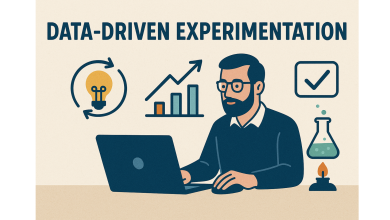
A recognized expert in project management and big data with experience at Intel and creator of the hybrid Scrum-a-fall methodology, she reveals the secrets of successful big data management.
In 2024, companies worldwide faced unprecedented growth in the volume of unstructured data. According to the analytics firm Forrester, the amount of such data managed by enterprises has doubled, leading to serious challenges in their storage, processing, and protection. With the implementation of artificial intelligence (AI) and machine learning (ML) technologies, data volumes are soaring into tens of petabytes, causing companies immense difficulties in management. As a result, about 80% of new data pipelines developed in 2024 will be designed specifically to work with unstructured data.
Maya Yacobovitch, an expert in project management and former Intel analyst, offers innovative solutions for companies dealing with big data. Her hybrid project management method — Scrum-a-fall — has already proven effective in large-scale projects by combining Agile’s flexibility with Waterfall’s reliability. Beyond this, Maya actively participates in international conferences such as Big Data & AI World and the PMI Global Conference. Her work has been recognized at scientific forums for contributing to the optimization of data management processes. Maya shares valuable insights on how modern organizations can adapt to the challenges of the big data era, enhancing efficiency while reducing costs. This approach helps address key challenges and shows how hybrid management methods support organizations in overcoming these obstacles.
The Era of Big Data: A New Challenge for Business
Today, companies are grappling with an avalanche-like growth in data volumes, especially unstructured data such as videos, audio recordings, and text from social media. In 2024, the volume of unstructured data that enterprises are obliged to store and process has doubled compared to 2023. Moreover, data not only accumulates but also becomes a crucial resource for strategic decision-making.
“Big data becomes both an invaluable asset and a significant problem for many organizations,” explains Maya Yacobovitch. “Companies often realize the necessity of data analysis but lack sufficient infrastructure for storage, processing, and protection. It’s like having a huge oil reserve that you cannot refine into useful products. Without the right tools and methodologies, data loses its value.”
Maya Yacobovitch emphasizes the importance of developing customized data strategies that are tailored to the specific needs of each organization. These strategies allow companies to handle both structured and unstructured data efficiently, ensuring that the growing volumes of information are not just stored, but also used effectively for strategic decision-making.
The implementation of AI and ML technologies intensifies this burden: to analyze and utilize such data for forecasting and developing new products, companies need to adopt modern technologies. However, this is where difficulties arise. Many enterprises need more infrastructure and expertise for effective management of large volumes of information.
In addition to this, there is a tightening of data protection regulations, such as GDPR in Europe and similar laws in the U.S., and it becomes clear that businesses can no longer ignore this problem. For modern enterprises, effective big data management is not just a competitive advantage but a critical necessity for growth.
Maya Yacobovitch: An Expert Who Changes the Game
One individual offering fresh and effective solutions amid the explosive growth of data is Maya Yacobovitch. Her seven years of experience at Intel and her education in industrial engineering, along with an MBA in business management, have given her a unique understanding of managing complex projects within a global corporation. What truly makes her approach innovative is her development of the hybrid project management methodology known as Scrum-a-fall.
In addition to her project management expertise, Maya has also developed sophisticated dashboards that help organizations visualize their data in real-time. These dashboards offer key performance indicators (KPIs) and other critical metrics, providing top-level management with the insights they need to make informed decisions quickly.
During her tenure at Intel, Maya spearheaded large-scale project management initiatives that included both structured data and unstructured data sets. She quickly realized that standard methods like Waterfall and Agile were often insufficient for big data projects, where flexibility and precise planning must go hand in hand. This realization led her to create Scrum-a-fall—a method that combines the agility of Agile with the structured planning of Waterfall. This approach enables companies to adapt swiftly to changes without losing sight of long-term goals.
Implementing this hybrid methodology at Intel yielded impressive results: Maya streamlined processes to reduce project development time, improved team collaboration, and enhanced the efficiency of handling growing data volumes. Her innovative method was so successful that it was adopted in several other big data projects. Scrum-a-fall has allowed companies not only to adapt to new market conditions but also to reduce project management costs.
Big Data — Big Problems: What Prevents Companies from Working Effectively with Information?
Despite these advancements, effective big data management remains a significant challenge for most companies. One of the main barriers is the ever-increasing volume of information. In 2024, according to Forrester’s forecasts, the volume of unstructured data that companies handle will double. This escalation means enterprises must tackle multiple tasks simultaneously: storing, processing, and analyzing vast amounts of data.
Many companies struggle with planning and organizing processes. Traditional data storage systems can’t cope with the scale, leading to decreased performance and increased expenses. Maya’s approach allows organizations to combine various streams of data — both structured and unstructured—into a single, coherent system, improving overall efficiency and data accessibility. Scrum-a-fall helps address this by allowing companies to meticulously plan long-term projects while enabling adjustments at each stage. This is crucial when working with big data, where flexibility and adaptability are key success factors.
Another pressing issue is data security. As data volumes grow, so do the risks of leaks or theft. In an era of stringent regulations like GDPR, companies are obligated to uphold high standards of data protection. This adds complexity to data management: businesses must not only process and store data but also safeguard it against cyber threats. Maya’s solution facilitates the implementation of effective tools for big data management, ensuring security control at every stage.
Companies unable to adapt to these new challenges risk falling behind competitors. Mastery in handling data is no longer just an advantage; it’s a vital necessity for success in a rapidly evolving digital world.
Scrum-a-fall: A Hybrid Method for Big Data
For companies dealing with enormous data volumes, adapting to technological and procedural changes is critical. Scrum-a-fall is ideally suited for this purpose: Agile empowers teams to make swift decisions and adjustments as new data emerges, while Waterfall ensures the project follows a clearly defined plan with established checkpoints. This combination offers high project manageability even amidst dynamic data changes.
“One of the key advantages of Scrum-a-fall is its ability to balance operational changes with long-term strategy,” emphasizes Maya Yacobovitch. “In the world of big data, forecasts and trends can shift rapidly, and the methodology must be flexible enough to adapt while staying within the overall plan. This is what makes Scrum-a-fall so effective for large projects.”
Companies utilizing this methodology can organize processes to execute large projects with precise planning while remaining agile to incorporate changes as new data arises. For example, when implementing an AI-based big data analytics system, a company can adjust algorithms based on incoming data
Practice vs. Theory: How Companies Benefit from Hybrid Methods
The application of Scrum-a-fall has already proven effective in several large-scale projects. At Intel, where the method was first implemented, it demonstrated its efficacy in projects involving big data processing and management. Maya notes that by employing this hybrid methodology, project completion times were reduced by 20–30%, thanks to Agile’s capacity to respond swiftly to changes and optimize processes in real-time.
The success at Intel spurred further adoption of Scrum-a-fall across other industries. A notable example is an international healthcare company that faced the challenge of processing massive volumes of medical data. Implementing Scrum-a-fall allowed the company not only to organize data processing more efficiently but also to reduce project management costs. The company reports time and resource savings of 25% compared to previous project management methods.
Saving Time and Resources
A key outcome of applying Scrum-a-fall is the ability to reduce both time and financial costs. The hybrid management model helps companies avoid delays in later project stages, which is especially important when dealing with big data that can rapidly change or expand. Agile elements enable adaptation during execution, while Waterfall maintains the overall structure and planning.
Using this approach in big data projects has shown that companies can cut expenses by 15–20% through process optimization and preventing resource overuse. Simultaneously, the method’s flexibility accelerates the launch of new products and services, a critical advantage in highly competitive markets.
Scrum-a-fall also enhances data security by structuring processes so that each project stage includes control over data access and processing. This is vital amid stricter regulations and escalating data security threats, where companies must comply with rigorous confidentiality and information protection standards. Employing a hybrid approach helps minimize data leakage risks and boosts process reliability.
Five Key Tips from Maya Yacobovitch for Managing Big Data
With extensive experience in project management, Maya Yacobovitch offers concrete steps to help companies effectively handle big data. Drawing from her time at Intel and the implementation of Scrum-a-fall, she outlines five essential tips for successful management of large information volumes:
1. Invest in Adaptive Systems
Big data is in constant flux, and the ability to adapt quickly is crucial for business. Investing in flexible systems and tools that can scale with data growth allows companies to respond promptly to changes and avoid losses from outdated technologies.
2. Clearly Define Project Goals
Effective big data management requires clearly defined objectives. Whether related to data storage, analysis, or security, having a specific plan keeps the company on track, preventing data chaos and unnecessary expenditures.
3. Implement Hybrid Management Methods
Hybrid methods like Scrum-a-fall combine flexibility with structure. Use Agile for swift adjustments during the project and Waterfall for long-term planning. This approach enables adaptation to new data and market demands without losing overall control.
4. Ensure Data Security
As information volumes grow, security becomes a top priority. Cyber threats and new regulations like GDPR present additional challenges. Implement data management systems that provide robust protection at all levels.
5. Train Employees
Technologies and management methods evolve rapidly, and your staff must keep pace. Continuous training and skill development help the company remain agile and effective amid increasing data volumes.
The Future Lies in Big Data: How Can Companies Prepare for New Challenges?
The future of big data promises even more challenges and opportunities for businesses. In the coming years, we’ll witness a continued surge in the amount of information companies must process, store, and analyze. New technologies—from more sophisticated machine learning algorithms to increasingly automated data processing systems—will play a pivotal role.
However, as data volumes grow, so does the complexity of managing them. In this context, hybrid methods will become indispensable tools for companies. These approaches help navigate dynamic data changes, offering both flexibility and structure—critical for successful project management in the big data era.
Companies that start implementing flexible yet structured management methods today, like those proposed by Maya Yacobovitch, will be better prepared for upcoming challenges. Hybrid methods will not only help manage data volumes but also extract maximum value from them, turning data into a competitive advantage.



